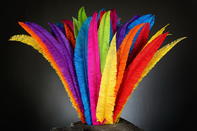The South African ostrich industry was created around the commercial farming of ostriches for their feathers and led to the crossbreeding of ostrich species to produce better quality feathers. For example, South African Black ostriches had much longer, 3.4%, feathers than ‘Zimbabwean Blue’ ostriches, a valued trait that resulted in better prices.

Harvesting of Feathers
From about 1975, the ostrich industry diversified to include ostrich meat and skins with the result that today, ostrich feathers make up about 10 - 15 % of the income of an ostrich farmer.
The majority of ostrich feathers, 60% are sourced from slaughter animals and are plucked after death. Some feathers are harvested from live animals, mostly breeder birds, and care is taken to only cut the dried feathers that would have been shed naturally. No immature or green feathers may be harvested on the farm. Green feathers are also called ‘blood feathers’. These are feathers that are not yet ‘ripe’ or dry.
Feathers from breeder birds are normally harvested during the rest period from February to April/May. The feathers should be harvested at the beginning of the rest period, to allow regrowth before the start of the new breeding season. Good feeding will ensure the proper development of new feathers.
The average yield of feathers per ostrich is about 1.2 kg.
After plucking, feathers are tied in bunches and sent for sale. After being sold, feathers are sterilised by heating it to 70℃ for 20 minutes in an air-tight container. The feathers are then washed with water and soap, dried in a steam-heated tumble dryer and after being graded according to length and quality, can be coloured or processed, depending on the final product.
Storage of feathers before processing is avoided, but if necessary, feathers should be protected against moths.
Types of Feathers
The Ostrich Manual (2014) published by the Western Cape Department of Agriculture classifies ostrich feathers into the following types:
The large plumes or wing quills are called ‘whites’ or ‘feminas’.
Byocks are the three to five black-and-white feathers at the end of the row of large white wing feathers.
The long upper wing coverts are the second and third rows of feathers on the outer edge of the wing, above the wing quills.
The soft, downy feathers underneath the ostrich wing are called ‘floss’.
The long tail feathers are harvested from the tip of the ostrich’s tail.
Sides or ‘bodies’ are the feathers in front of and behind the bird’s powerful thighs.
On average, the body feathers of an ostrich can total 850 - 900 gm per bird and the wing feathers around 240 gm per bird.
The Price of Ostrich Feathers
Ostrich feathers usually make up 10 - 15 %, but can comprise up to 30% of total slaughter income from an ostrich, says Dr Adriaan Olivier of the South African Ostrich Business Chamber. Feathers for the fashion industry, for example, demand high prices but are also subjected to very strict quality demands.
According to Peter Liebenberg of Klein Karoo International, an ostrich processor in Oudtshoorn, a farmer can earn an average price of R1 500 - R2 000 per ostrich, but some earn up to R2 600 per ostrich for good quality feathers (2019).
There is no difference in the quality or price between the feathers of male and female ostriches. The price of ostrich feathers is determined by feather quality, down quality and down density.
Ostrich Feather Quality
Feather quality is determined by attributes such as the breadth and symmetry, size and appearance of the feather. The quill length and down qualities such as down density and gloss also determine overall feather quality.
Ostrich Feather Products
The various quality grade and types of ostrich feathers are used for specific applications. For example, large wing feathers of 30 cm and longer can be used for costumes, while ostrich down is used for feather dusters. Ostrich feathers generate static electricity, which attracts and retains dust, making soft ostrich feather dusters ideal to clean fragile objects.
Ostrich feathers are also used to make items such as boas, neck warmers, hair accessories, handbag trimmings, cushions and key holders.
About 80% of South African ostrich feathers are exported, usually packed in boxes of 10 to 50 kg each.
By Marinda Louw